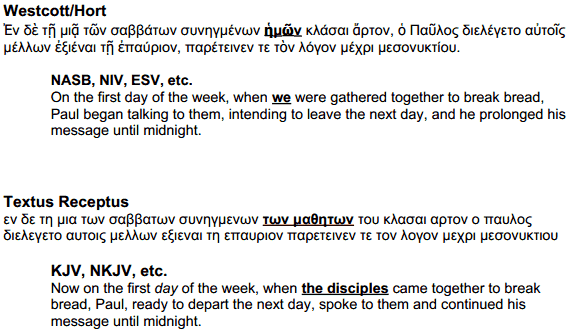If you’ve spent much time comparing passages from newer translations of the Bible (NIV, NASB, NKJV, etc) to the King James Version, you’ve noticed that some verses, or portions of verses, have been moved from the main text into a footnote. The footnotes usually say that the verse does not appear in the earliest and most reliable manuscripts.
Why are these verses questioned by scholars and Bible translators? Are they trying to discard portions of the Bible? Are they attempting to achieve some dark objective which results in casting doubt upon the inspiration of the Bible? The quick answer is that nothing sinister is going on. Rather than “removing” verses, the translators have valid reasons to believe that some verses should have never been in the Bible to begin with.
Manuscript Evidence
Many people have the mistaken impression that the Bible in the original Hebrew and Greek languages is some sort of singular or monolithic document. In reality, scholars have thousands of manuscripts that were all copied at different times and in different places. The ancient scribes were fanatical about accurately replicating the documents, but they were human and humans make mistakes. Over the centuries, minor variations crept into the text.
Textual Criticism
Textual criticism is a branch of literary criticism that seeks to identify transcription errors in an effort to determine exactly what the original Bible documents said. The process of textual criticism involves comparing thousands of manuscripts with each other and drawing conclusions about the various scribal errors. The end result of this work is a document used as a textual base for translating into other languages. For example, two New Testament documents of this sort are the Greek New Testament and the Westcott-Hort Critical Text.
The King James version translators relied upon the Greek New Testament which was compiled by a man named Erasmus (1469-1536). Erasmus compiled his translation base using only 6 manuscripts that dated from the 12th century and did not contain the entire Bible. The text that was absent from the manuscripts Erasmus used was translated from Latin back to Greek using the Vulgate (a Latin translation of the Bible). Subsequent versions of Erasmus’s Greek New Testament became known as the “Textus Receptus”.
By the late 1800s, more manuscripts had been discovered that were older and considered more reliable than any Erasmus used. Two men by the names of Brooke Westcott and Fenton Hort compiled a new translation base they titled “New Testament in Greek”, later known as the “Critical Text”. The Critical Text became the standard used by two generations of translators. The English Revised Version and the American Standard Version are two Bible translations that used the Westcott & Hort text as their translation base.
Example
The image below shows two variant readings from Acts 20:7 from the Textus Receptus and the Westcott & Hort text.

In this instance, one Greek translation base uses the word “we” and the other uses “the disciples”. Which reading was more likely the one the author of the book of Acts wrote in his original document? In this particular example, modern scholarship leans in favor the of word “we”.
Some of the more recently discovered manuscripts that are older than anything available in Erasmus’s day do not contain some verses (or portions of verses). Textual criticism tries to determine which reading is more probable when such a discrepancy arises. When making such decisions, scholars consider the age of the manuscripts, their quality, what part of the world they are from, consistency in grammar, etc.
With all of this in mind, perhaps we should consider the question the other way around. Instead of asking “Are verses missing?”, perhaps we should be asking “Were verses added?”
Conclusion
It is important to keep in mind that even though there are textual variations in the Bible manuscripts, they are all of minor significance. None of the discrepancies affect the Bible’s crucial teachings. Even if the “missing” verses were completely removed, the Bible’s message would not be altered.
The King James Bible was translated over 400 years ago and many Biblical manuscripts have been discovered since then. Many of the more recent discoveries are older than anything the KJV translators had access to and are considered more accurate. Simply put, today’s Bible translators have the benefit of greater knowledge and better manuscripts than the translators of the KJV had in the early 1600s.
